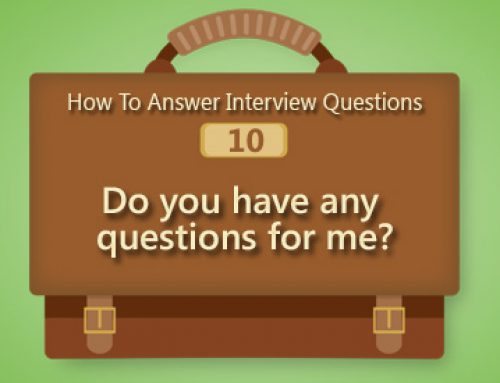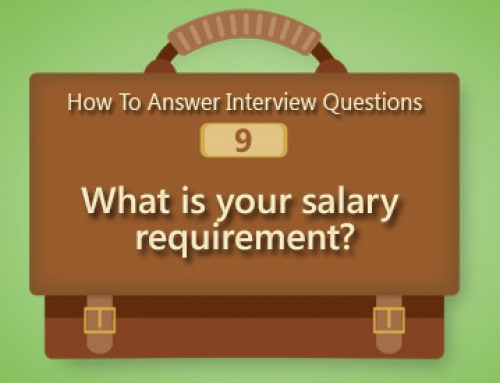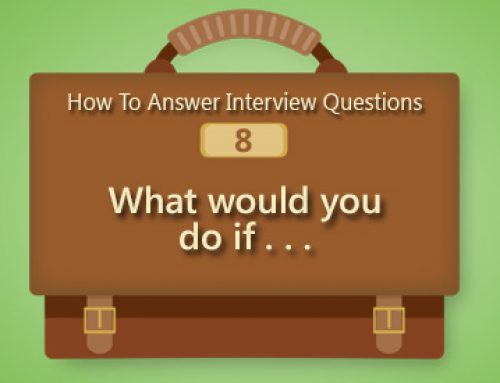7. “Tell me about a time when you……”
Watch the great movie comedy, Airplane (1980) to see a memorable example of how to answer this interview question. It shows what NOT to do. The character of Ted Stryker talks to different people that are seated next to him as he goes on and on and on. His unlucky seatmates kill themselves as the only way to escape him. Then he continues to talk, completely unaware of their distress.
Select the right stories to tell, choose which details to leave in and which to take out and follow the proven Movie Moments story telling format. Those factors can be your job-winning difference. Avoid the risk of making your interviewer want to reach for a rope or samurai sword (as they had to do in Airplane) to escape you.
Good Interview Answers for this Popular Interview Question
To reply to this frequently asked top ten interview question, do this instead. Here’s the interviewer’s side of what they want to hear (and don’t want to hear) for this question.
Alternate versions of this question include:
Almost unlimited questions for any situation, skill or behavior they see as potentially arising in the job or their organization. This type of question is often called a “Behavioral Interview Question.” They want you to describe what you did specifically when faced with this situation in your past. Questions might include:
- “Tell me about at a time when you had a disagreement/confrontation/conflict with a boss/coworker.”
- “When you made a mistake, tell me what you did to fix it.”
- “Tell me about a really difficult client or customer.”
- “Share an instance when you faced a significant barrier to accomplishing something.”
- “I’d like to hear about when you were facing a deadline you discovered couldn’t meet.”
- “What was a significant achievement in a prior job?”
- “How did you handle it when a coworker wasn’t pulling their share of the workload?”
- “Tell me about the most difficult assignment you’ve ever had.”
- “Can you give me an example of what you did to keep up when you were working in a fast-paced environment.”
- “On your resume, you say you are a hard worker. Can you give me an example of a specific time when you were working very hard?”
- “Tell me about a time when you had to adapt to a change quickly.”
And on and on. They can ask about anything and everything so you should be prepared. Therefore be ready to address technical or task related challenges you’ve faced as well as personal and interpersonal behaviors and habits.
Your answer should be:
- about one specific instance, not a collection of incidents
- a complete story that follows the Movie Moment format with all three parts (See Here’s How to Create Your Answer below)
- inclusive of the lessons you learned, particularly if you would handle the incident differently in the future
Your answer should not be:
- general
- a combination of multiple situations
- missing the beginning, middle or end
- too long
- including unnecessary detail instead of your actions and thoughts
Here’s How to Create Your Answer:
Your interviewer could also ask you for an example from your resume. They could follow-up from something you said about yourself in a prior answer. Therefore prepare as much as possible in advance. Review your history and remind yourself of key life and work experiences. You may have the opportunity to share.
How do you look for your own stories? Start with the personality traits, behaviors, skills and knowledge from the job posting. Then look through your own resume (and your memory.) Find the moments in your past that match, or are similar. Use them to provide proof and evidence of your accomplishment and effectiveness.
Once you’ve identified your matching situations, then turn them into movie moments format. I love movies, and movie scenes serve as a perfect example of what you need to do to prepare each of your examples.
Movie Moments Story Formula
- Establish the Opening Scene – Where and when does this take place? How are you involved? What’s the problem, crisis or situation that you are asked to solve? Or do you act because you see a need or an opportunity to make something better? This first section should take about 20% of the time when you share your movie moments.
- Show You in Action – As the star of the movie, what are you doing?What are the key actions you’re taking? List your major behaviors to solve the problem. Who else are you involving? How are you taking effective action? What specific obstacles or conflicts do you have to overcome? (When you talk here, beware of the “we trap” that is deadly. Make sure you talk about your role, even if it’s in the context of the team’s solution.) This second section should take about 60% of the time when you share your movie moments.
- Describe the Successful End – Don’t forget to include the end of this scene and talk about how things turned out and how the company benefited from your actions and the solution. This should take about 20% of the time when you share your movie moment.
Example #1
Q: Tell me about a time when you had to handle an irate customer.
A: “I work part-time with my mother in a coffee shop. There was one time where there was a mistake made on my part on their order. The person was in a hurry, and this was their first time there. I rectified the situation by remaking their drinks, giving them a free coupon, apologizing profusely and telling them that we appreciate their business. They became a regular. Not only do they still come in but they’ve also brought other people from their office over to us.”
Example #2
Q: Tell me about a time where you had to work with a team to accomplish something, and there were tight deadlines.
A: “During my time at XXX, I was in media planning and buying. So, I was given marketing goals and objectives as well as a budget by the client. I had to take those objectives and the budget, the monetary amount, into consideration. I worked with various vendors that had to fit within that client’s marketing goals and objectives. Then I needed to make sure that it was the right platform for their marketing messages.
One particular client that I had worked with was an auditing and consulting firm and didn’t have a whole lot of experience with that sector, but got thrown into the project. My strength is working in the business-to-business arena, so I gladly took it on and took on the role of the account manager of that account.
We, as a team, had to develop an annual meeting plan for this particular client and since I was the account manager, I spearheaded reaching out to the vendors and requesting proposals and also coordinating those proposals with a digital team and working with the broadcast team.
So, there was the vendor relationship I had to manage as well as the client relationship and then the various people on the team. I had to complete the project within about a month’s time, which usually we are given about eight weeks for a project like that.
So I kept in excellent communication with the vendors, with the client, with my team. I kept everyone in the loop and made sure that everyone was on task and that we were going to meet the deadline, which we did. We were able to complete the media plan; it was in the four-week period.
The client was very pleased with the final outcome and ended up signing off on the plan without a whole lot of edits. I was actually able to go and meet the client directly at their office. So that was a really nice way of appreciation of my work on the team and how I was able to get everyone together to complete this project in a short amount of time.”
Example #3
Q: Tell me about a time when you had a really big workload, maybe more than you felt you could handle. How did you handle it?
A: ” I can think of a previous position I had at XXX. We had a bunch of fixes for the database that went in. It changed the way some queries in our back end function worked, so what we ended up doing for about a week and a half was putting in a lot of emergency changes, doing a lot of tweaks to the queries we were running, and it was a challenge.
Put in a lot of overtime hours on that even though I was on salary because it was the right thing to do. I was supporting some other people on my team, and they were supporting me. The way I got through it, the way we all got through it, was breaking things down – what things have to act on absolutely, what things can wait and then do it piecemeal one at a time. Eventually, we did get things back to normal production runs going in and we were all able to breathe a massive sigh of relief.”
Test Yourself with This Example:
Here is one specific answer from a candidate’s experience that with a little tweaking could be used to answer several different questions. Read the answer and then identify some of the questions where this could be the foundation for a response.
“I remember way back when I was working in Boston; I worked with a young woman who already at age 19 had two children and had dropped out of school. We got her into a GED program and then an LPN Program. I had a difficult situation I needed to handle with a key funder of that program. She said, “we funded you to support 100 people like this, and you only worked with 12 or 15!”
I remember saying “wasn’t it worth it? The fact that 10 of the 15 that we work with are no longer on public aid, they’re now back in school and functioning members of society. Those are the memorable ones, when we can really reach those young people who were high-risk young people going down the wrong path and we could turn their lives around and make them productive members of a community, isn’t that worth the investment?”
The funder laughed. She got what I was saying. Then I put money into it. I said “you gave us $100… whatever it was…$100,000 to work with these 100 children and I said turning this one young woman’s life around saved the state and those two children, because she’s now a nurse.
So, the likelihood is that those kids are not going to ever be on welfare or public aid. They’re going to grow up and get through high school. We not only affected this one young woman’s life, but we also affected her two children’s lives. So talking about we saved a lot of money over the long run, just from that one family.” So that’s how I did it. Then she got it, and she was like “okay, you’ve convinced me.”
It was also a learning lesson for me to be more proactive with my funders. To be able to tell them upfront the hurdles that we were having. These were either in recruiting or that to turn these young people’s lives around we needed to be more intense. Therefore we had to work with fewer people rather than more.”
NEED SOME MORE HELP?
Finally, to further improve your own answer to this question, get immediate access to the “TELL ME A STORY” Guide in the Hollywood Movie Method Job Winning Series. This Guide includes 12 sample answers given by real people for this question. You will discover ratings for each answer that will help you quickly refine your own answer to be even more effective.
This Guide also includes samples and complete how to answer training for even more questions you face in your job interviews.






